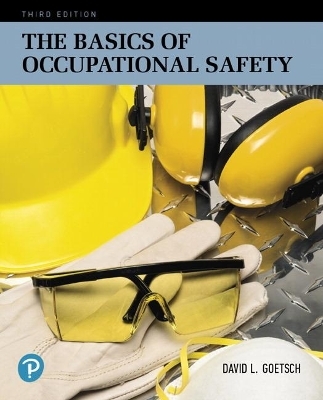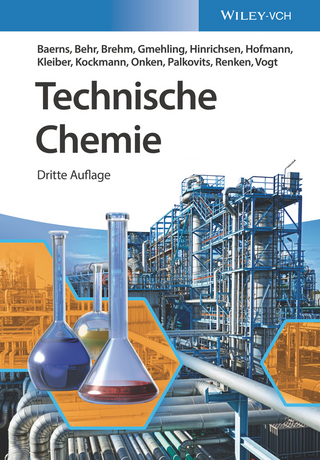
Basics of Occupational Safety, The
Pearson (Verlag)
978-0-13-467871-9 (ISBN)
- Titel z.Zt. nicht lieferbar
- Versandkostenfrei innerhalb Deutschlands
- Auch auf Rechnung
- Verfügbarkeit in der Filiale vor Ort prüfen
- Artikel merken
Complete guide to basic workplace safety, across technical fields
The Basics of Occupational Safety fills the need for a practical teaching resource introducing students to the basics of workplace safety. In his hallmark easy-to-read style, Goetsch examines the latest standards of OSHA, NIOSH, and other US regulatory bodies in the context of new and emerging industry trends. The text suits students in secondary and postsecondary technical programs who need one occupational safety course, such as students of manufacturing, welding, carpentry, and electronics.
The 3rd edition is a major revision encompassing new and revised regulations and other updates of importance to students of occupational safety and health.
About our author Dr. David L. Goetsch is Vice-President Emeritus and Professor of Safety and Quality Management at Northwest Florida State College, where he has served for 40 years. He is the author of numerous Pearson books. In addition to Occupational Safety and Health, 9th Edition, he is also the author of The Basics of Occupational Safety, 3rd Edition; Construction Safety and the OSHA Standards, 2nd Edition; Quality Management for Organizational Excellence, 8th Edition; and numerous others. He has been America's Outstanding Technical Instructor of the Year and Florida's Outstanding Technical Instructor of the Year. In 2016, he was inducted into the Florida Veteran's Hall of Fame for significant contributions to higher education for veterans in Florida.
CHAPTER 1: SAFETY AND HEALTH MOVEMENT, THEN AND NOW
Developments Before the Industrial Revolution
Milestones in the Safety Movement
Tragedies That Have Changed the Safety Movement
Role of Organized Labor
Role of Specific Health Problems
Safety and Health Standards Apply to More than Just Manufacturing
Development of Accident Prevention Programs
Development of Safety Organizations
Safety and Health Movement Today
Integrated Approach to Safety and Health
New Materials, New Processes, and New Problems
Rapid Growth in the Profession
Does Moving Manufacturing Jobs Overseas Reduce the Accident Rate?
CHAPTER 2: ACCIDENTS AND THEIR EFFECTS
Costs of Accidents
Accidental Deaths in the United States
Accidents versus Other Causes of Death
Work Accident Costs and Rates
Time Lost because of Work Injuries
Deaths in Work Accidents
Work Injuries by Type of Accident
Death Rates by Industry
Parts of the Body Injured on the Job
Estimating the Cost of Accidents
Global Impact of Accidents and Injuries
OSHA Reports and Logs
CHAPTER 3: THEORIES OF ACCIDENT CAUSATION
Domino Theory of Accident Causation
Human Factors Theory of Accident Causation
Accident/Incident Theory of Accident Causation
Epidemiological Theory of Accident Causation
Systems Theory of Accident Causation
Combination Theory of Accident Causation
Behavioral Theory of Accident Causation
Individual Factors and Accident Causation
Management Failures and Accident Causation
Obesity and Accident Causation
Swiss Cheese Model of Accident Causation
Summary of Accident Causation Models and Applications
CHAPTER 4: ROLES AND PROFESSIONAL CERTIFICATIONS FOR SAFETY AND HEALTH PROFESSIONALS
Modern Safety and Health Teams
Safety and Health Manager
Engineers and Safety
Industrial Hygienist
Health Physicist
Occupational Physician
Occupational Health Nurse
Risk Manager
Employees and Safety
Certification of Safety and Health Professionals
Other Safety and Health-Related Certifications
Emerging Role of Safety Professionals
CHAPTER 5: THE OSH ACT, STANDARDS, AND LIABILITY
Rationale for the OSH Act
OSHA's Mission and Purpose
OSH Act Coverage
OSHA Standards
OSHA's Record Keeping and Reporting
Keeping Employees Informed
Workplace Inspections and Enforcement
OSHA'S Whistleblower Program
OSHA's Enhanced Enforcement Policy
Citations and Penalties
OSHA Fines: How Much and Where Does the Money Go?
Appeals Process
State-Level OSHA Programs
Services Available from OSHA
Employer Rights and Responsibilities
Employee Rights and Responsibilities
Keeping Up-to-Date on OSHA
Problems with OSHA
Other Agencies and Organizations
OSHA's General Industry Standards
OSHA's Maritime Standards
OSHA's Construction Standards
Standards and Codes
Laws and Liability
OSHA's Stand on Safety Incentives
CHAPTER 6: WORKERS' COMPENSATION
Overview of Workers' Compensation
Historical Perspective
Workers' Compensation Legislation
Modern Workers' Compensation
Workers' Compensation Insurance
Resolution of Workers' Compensation Disputes
Injuries and Workers' Compensation
Disabilities and Workers' Compensation
Monetary Benefits of Workers' Compensation
Medical Treatment and Rehabilitation
Medical Management of Workplace Injuries
Administration and Case Management
Cost Allocation
Problems with Workers' Compensation
Spotting Workers' Compensation Fraud and Abuse
Future of Workers' Compensation
Cost-Reduction Strategies
CHAPTER 7: ACCIDENT INVESTIGATION AND REPORTING
Types of Accident Investigations
When to Investigate
What to Investigate
Who Should Investigate
Conducting the Investigation
Interviewing Witnesses
Reporting Accidents
Ten Accident Investigation Mistakes to Avoid
CHAPTER 8: ERGONOMIC HAZARDS: MUSCULOSKELETAL DISORDERS (MSDs) AND CUMULATIVE TRAUMA DISORDERS (CTDs)
Ergonomics Defined
Human Factors and Ergonomic Hazards
Factors Associated with Physical Stress
Ergonomics: A Political Football
OSHA's Voluntary Ergonomics Guidelines
Worksite Analysis Program for Ergonomics
Hazard Prevention and Control
Medical Management Program
Training and Education
Common Indicators of Problems
Identifying Specific Ergonomic Problems
Ergonomic Problem-Solving Strategies
Economics of Ergonomics
Cumulative Trauma Disorders/Soft Tissue Injuries
Lifting Hazards
Helpful Assessment Tools: NIOSH, RULA, REBA, and HAL
Participatory Ergonomics
CHAPTER 9: STRESS AND SAFETY
Workplace Stress Defined
Sources of Workplace Stress
Human Reactions to Workplace Stress
Measurement of Workplace Stress
Shift Work, Stress, and Safety
Improving Safety by Reducing Workplace Stress
Stress in Safety Managers
Stress and Workers' Compensation
CHAPTER 10: MECHANICAL HAZARDS AND MACHINE SAFEGUARDING
Common Mechanical Injuries
Safeguarding Defined
OSHA's Requirements for Machine Guarding
Risk Assessment in Machine Operation
Design Requirements for Safeguards
Point-of-Operation Guards
Point-of-Operation Devices
How to Choose a Machine Guard or Device
Machine Guarding Self-Assessment
Feeding and Ejection Systems
Robot Safeguards
Control of Hazardous Energy (Lockout/Tagout Systems)
Permanent Electrical Safety Devices in Lockout/Tagout Programs
General Precautions
Basic Program Content
Taking Corrective Action
CHAPTER 11: FALLING, IMPACT, ACCELERATION, AND VISION HAZARDS WITH APPROPRIATE PPE
Causes of Falls
Kinds of Falls
Walking and Slipping
Slip and Fall Prevention Programs
OSHA Fall Protection Standards
Ansi Z359 Fall Protection Code
Ladder Safety
What to Do After a Fall
Monitor Fall Protection Equipment and Know Why It Fails
Impact and Acceleration Hazards
Standing Hazards
Hand Protection
Personal Protective Equipment
Forklift Safety (Powered Industrial Trucks)
CHAPTER 12: HAZARDS OF TEMPERATURE EXTREMES
Thermal Comfort
Heat Stress and Strain
Cold Stress
Burns and Their Effects
Chemical Burns
OSHA's Guidelines for Hazards of Temperature Extremes
CHAPTER 13: PRESSURE HAZARDS
Pressure Hazards Defined
Sources of Pressure Hazards
Boilers and Pressure Hazards
High-Temperature Water Hazards
Hazards of Unfired Pressure Vessels
Hazards of High-Pressure Systems
Cracking Hazards in Pressure Vessels
Nondestructive Testing of Pressure Vessels
Pressure Dangers to Humans
Decompression Procedures
Measurement of Pressure Hazards
Reduction of Pressure Hazards
OSHA's Standard and Guidelines for Pressure Hazards
Confined Spaces and Pressure Vessels
CHAPTER 14: ELECTRICAL HAZARDS
Electrical Hazards Defined
Sources of Electrical Hazards
Electrical Hazards to Humans
Detection of Electrical Hazards
Reduction of Electrical Hazards
OSHA's Electrical Standards
Electrical Safety Program
Electrical Hazards Self-Assessment
Prevention of Arc Flash Injuries
Training Requirements for Workers
Permanent Electrical Safety Devices
Hazards of Power Strips and Daisy Chains
CHAPTER 15: FIRE HAZARDS AND LIFE SAFETY
Fire Hazards Defined
Sources of Fire Hazards
Fire Dangers to Humans
Detection of Fire Hazards
Reduction of Fire Hazards
Development of Fire Safety Standards
OSHA Fire Standards
OSHA and Fire Prevention Plans
OSHA Requirements for Exit Routes
Life Safety
Basic Requirements
Flame-Resistant Clothing
Fire Safety Programs
Response and Fire Drills
Explosive Hazards
OSHA's Firefighting Options
Self-Assessment in Fire Protection
Hot Work Program
CHAPTER 16: INDUSTRIAL HYGIENE AND CONFINED SPACES
Overview of Industrial Hygiene
Industrial Hygiene Standards
OSH Act and Industrial Hygiene
Hazards in the Workplace
Toxic Substances Defined
Entry Points for Toxic Agents
Effects of Toxic Substances
Relationship of Doses and Responses
Airborne Contaminants
Effects of Airborne Toxics
Effects of Carcinogens
Asbestos Hazards
Indoor Air Quality and “Sick-Building" Syndrome
Toxic Mold and Indoor Air Quality
ASTM D7338: Guide for the Assessment of Fungal Growth in Buildings
Threshold Limit Values
Hazard Recognition and Evaluation
Prevention and Control
NIOSH and Industrial Hygiene
NIOSH Guidelines for Respirators
Standards and Regulations
Environmental Protection Agency Risk Management Program
General Safety Precautions
Nanoscale Materials and Industrial Hygiene
Confined Space Hazards
OSHA Confined Space Standard
OSHA's Hazard Communication Standard
CHAPTER 17: VIOLENCE IN THE WORKPLACE
Occupational Safety and Workplace Violence: The Relationship
Workplace Violence: Definitions
Legal Considerations
Risk-Reduction Strategies
OSHA's Voluntary Guidelines on Workplace Violence
Active Shooter Response
Role of Supervisors
Workplace Violence: Policy, Plan, and Programs
Communicating with Personnel in the Aftermath of a Violent Incident
CHAPTER 18: NOISE AND VIBRATION HAZARDS
Hearing Loss Prevention Terms
Characteristics of Sound
Hazard Levels and Risks
Standards and Regulations
Workers' Compensation and Noise Hazards
Identifying and Assessing Hazardous Noise Conditions
Noise Control Strategies
Vibration Hazards
Other Effects of Noise Hazards
Corporate Policy
Evaluating Hearing Loss Prevention Programs
Future of Hearing Conservation: Noise Reduction Rating
Distraction Hazards Introduced by Handheld Devices with Earbuds
CHAPTER 19: PREPARING FOR EMERGENCIES, DISASTERS, AND TERRORISM
Rationale for Emergency Preparation
Emergency Planning and Community Right-to-Know Act
Organization and Coordination
OSHA Standards
First Aid in Emergencies
How to Plan for Emergencies
Planning for Workers with Disabilities
Evacuation Planning
Customizing Plans to Meet Local Needs
Emergency Response
Computers and Emergency Response
Dealing with the Psychological Trauma of Emergencies
Recovering from Disasters
Terrorism in the Workplace
Reporting Suspicious People and Behaviors
Active Shooter Response
Resuming Business after a Disaster
CHAPTER 20: BLOODBORNE PATHOGENS AND BACTERIAL HAZARDS IN THE WORKPLACE
Symptoms of AIDS
AIDS in the Workplace
Legal Concerns
AIDS Education
Counseling Infected Employees
Easing Employees' Fears about AIDS
Protecting Employees from AIDS
Hepatitis B Virus (HBV) and Hepatitis C Virus (HCV) in the Workplace
OSHA's Standard on Occupational Exposure to Bloodborne Pathogens
Preventing and Responding to Needlestick Injuries
Methicillin Resistant Staphylococcus Aureus (MRSA) in the Workplace
| Erscheinungsdatum | 16.04.2018 |
|---|---|
| Sprache | englisch |
| Maße | 190 x 240 mm |
| Gewicht | 900 g |
| Themenwelt | Naturwissenschaften ► Chemie ► Technische Chemie |
| Technik | |
| Wirtschaft | |
| ISBN-10 | 0-13-467871-0 / 0134678710 |
| ISBN-13 | 978-0-13-467871-9 / 9780134678719 |
| Zustand | Neuware |
| Informationen gemäß Produktsicherheitsverordnung (GPSR) | |
| Haben Sie eine Frage zum Produkt? |
aus dem Bereich


